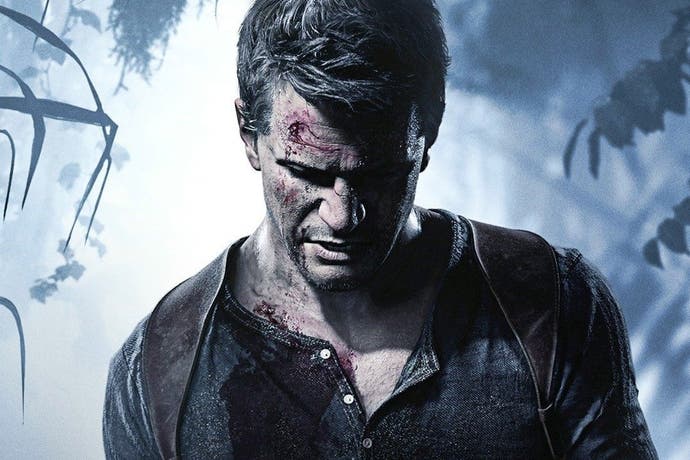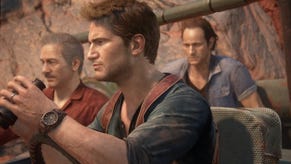Uncharted 4 pushes PS4 tech to the next level
Does the next-gen start when Naughty Dog says it does?
Despite the shaky start, it was worth the wait. Uncharted 4 concluded Sony's E3 show this year with style - an extravaganza of live gameplay that showed Naughty Dog's growing affinity for PlayStation 4 hardware. Compared to the meat and potatoes gameplay shown at the PlayStation Experience event in December, Nathan Drake's E3 showing pushes the game's technological credentials more forcefully, calling on the team's incredible talents in set-piece design. But having seen some accomplished current-gen titles over the past few months, is what we're seeing here the consummate next-gen game we've been waiting for?
Uncharted 4 goes much further than any PS4 or Xbox One game we've seen in its use of physics, and the layering of world detail with shaders. Opening at the gates of a bustling Madagascan marketplace, what unfolds is unlike any major title seen on console to date. Where the December demo focused on wide spaces, foliage systems, and its more flexible AI, the E3 demo goes to town with object physics applied across the world, as flaunted brilliantly with a jeep chase to 'Sam's tower' at the bottom of the city.
Indeed, vehicle control is at last planted fully in the player's hands this time - a choice that means we can carve out a unique route to hill's nadir. It's rare to see such rapid asset streaming go off without a pop-in hitch; for example, games like The Witcher 3 on PS4 operate at equivalent to PC's medium to lower settings, producing some obvious pop-in for shadows and foliage. The console's substantial reserve of fast GDDR5 memory only goes so far in solving this, and the rest comes down to smart control of LODs from the developers.
For Uncharted 4, the sheer speed of the descent shows just how effective Naughty Dog has been in this endeavor. Save for one brief texture flash just as Drake starts moving, no normal maps or geometry suffer from obvious pop-in, and draw distances are impressively broad across the horizon. All of which gives this sequence a surprising level of polish even in this early state, and it's a great example of a PS4 title handling a broad, detailed environment with few streaming issues - even if it does eventually lead to a funneling point.
As a bonus, motion blur is added since the PlayStation Experience demo, kicking in heavily during this chase, with both camera and per-object implementations. It adds a filmic touch sorely missing in the last showing, though a banding trail is also now left behind moving objects - likely an artefact of the temporal component utilized in Naughty Dog's chosen anti-aliasing technique. A recent post by Timothy Lottes (creator of the widely adopted FXAA algorithm) adds his two cents to this theory. The supreme, clear edge treatment in the December demo is seemingly swapped out in this E3 update, with Lottes suggesting a move to a "viewport-jittered neighborhood-clamped high-feedback temporal AA without MSAA."
It's quite a mouthful, but this essentially describes a set of algorithm modes for isolating and then treating jagged edges in post - especially during motion. The results speak for themselves; banding is more noticeable than the December demo (best seen in still images), but the 1920x1080 image is still presented with minimal pixel crawl while driving. Between the marketplace stalls, construction site dug-out, and the shimmering rice paddies near the river basin, each upcoming segment of the city is still easy to pick out.
Overall, it's a slight step back for Uncharted 4's image quality since the last demo, but the results are still ahead of most PS4 titles today. As a sign of future releases, it also suggests a native 1080p is still very much viable for PS4 releases pushing the envelope with a huge world, though developers are seemingly still keen to top this off with a post-process method of AA - and all the caveats that brings to absolute clarity.
Even so, this doesn't diminish the incredible level of detail layered across the city. Despite its broad, branching paths, each area is still richly defined, filled with unique alleyways and courtyards that players may never pass on their first play-through. Most impressive of all is the extensive use of physics across the world - with Drake's own jeep confirmed to use the Havok engine. Everything from his hair, shirt, and even the vehicle's antenna sway to the wind during the chase; small effects that stack up when applied across the game, lending real a sense of tangibility to the game world.
Drake's early shoot-out also makes a statement of intent for Uncharted 4's use of physics. Every object in the marketplace shatters or bounces off the next item, and players are seemingly never safe taking cover in one spot. With procedural chip damage in place as well, most spots deteriorate dynamically in the face of oncoming gunfire - ripping out chunks of the scenery to leave Drake exposed. It marks a departure from the slower, stealthier gameplay of the PlayStation Experience demo, and players are forced to keep moving to stay alive.
The extent of Uncharted 4's use of physics goes much deeper than you'd expect. One of the more surprising applications of this is one that goes unnoticed; rice bags actually deflate using a mesh distortion system Naughty Dog has in place, as detailed during a recent Headspace panel with the team. It's an effect also applied on Nathan Drake's face when pressed against the floor during the game's first blue-hued E3 2014 reveal. In essence, for this demo, it allows each sack to sink as rice leaks out from bullet-holes, where each shot cues a physics-based impact on the bag, while deflation is simulated using mesh distortion.
Mixed in with the physics on fence pickets and draping clotheslines, Uncharted 4 strives for a dynamic set-piece that unfolds differently with each play. Certain aspects are scripted, in particular the enemy truck pursuing Drake, but it's a big step up from the typical A-to-B setup in previous games. It is ultimately a directed experience, but the E3 2015 demo dovetails between open gameplay and scripted moments deftly enough to keep the illusion of agency alive.
It's a style of demo made famous with Uncharted 2's train versus helicopter sequence - a real technical showpiece for PS3 that dazzled crowds in a similar way back in 2009. Naughty Dog's ability to make the most of each processing cycle across the PS3's SPUs paid dividends back then, and this ranked among the first titles to show what intense optimisation for the machine could do. Fast-forward to today and it's a familiar story: Uncharted 4 on PS4 plays to the strengths of a multi-core CPU machine, where the physics, a labyrinth of intertwining paths, and a more reactive AI system show the team striving to turn heads all over again.
Based on a Game Informer interview, the PS4 entry also aims to do everything in-engine this time, rather than resort to the pre-encoded video cut-scenes used in the previous games. It's a likewise upgrade for Uncharted 4's lighting system; earlier titles on PS3 baked in lighting properties for each texture, but now it moves to a fully physically-based rendering approach. This means that the use of shaders now determines how light reacts; elements such as wetness, creasing, stitch density, scratches and all forms of weathering now have an impact on surfaces or characters.
The E3 build gives some superb examples of this shader system; in one moment, Drake's jeep passes through a construction site and leaves detailed mud tracks behind. These indents are applied dynamically, while other materials such as marble and glass react to lights with differing levels of opacity or reflectance - all shader-based reactions. As far as in-game character models are concerned, there's no major changes to Drake from his PlayStation Experience outing - though characters in the final scene show the use of subsurface scattering, with light filtering through character skin.
Based on this latest footage, Naughty Dog once again opts for a locked 30fps in gameplay, and with v-sync engaged. This falls in line with the PlayStation Experience gameplay, another demo locked to a 30fps output, though at a time when the team's original 60fps promise hung in the balance. Alas, it has since been confirmed in an interview that a solid 30fps for single-player is now the team's committed target, and judging by our gameplay analysis that's precisely what we're getting.
It's not squeaky clean; there are occasional one-off frame drops in our graph. However, these are anomalies in an otherwise seamless stretch of gameplay. PS4 is adept in handling everything Uncharted 4 throws at it, from the on-foot shoot-outs with heavy physics to streaming in new terrain during the car chase. By conceding to a 30fps lock the team is at least able to go all out with this set-piece; a preference compared to a theoretical 60fps that just can't be sustained.
Meanwhile a tweet from director Bruce Straley suggests Uncharted 4's multiplayer may well retain 60fps for those who are competitively inclined. No promises are made for a perfect lock at that target, but it's a feasible goal given the lessened focus on set-pieces, and a typically more contained map size than the single player offers. As a minimum, we hope its performance profile ends up close to the 50-60fps range of The Last of Us' excellent PS4 remaster.
But as a take-away, Naughty Dog's very first PS4 Uncharted is maturing nicely with each new demo, and it's fair to say this E3 2015 showing is the biggest crowd-pleaser yet. The decision to settle for 30fps means many things, and in particular for this set piece it opens the gates to a bigger, denser world, with a heavy focus on physics that might have been tougher to achieve at 60fps. From a technical perspective, it's a real evolution over the PlayStation Experience gameplay demo we saw seven months ago - a feat in world design that demanded current-gen hardware to achieve at such a level. We just hope that the more linear design seen here is matched with the more open-ended gameplay options showcased in the last demo. If there is a criticism to level at the new demo, it is that it's a turbo-charged version of what has come before as opposed to a genuinely new experience.
It's been a superb few months for those invested in PS4, especially with the arrival of big hits like Bloodborne, Project Cars and an excellent rendition of Batman: Arkham Knight. But along comes Uncharted 4 with a mandate to show what the future holds for this console generation, and in particular Sony's big exclusives. The jungles and cities shown so far are just the tip of the iceberg - only two stops on a globe-trotting tour for both Nathan Drake and Naughty Dog's talented artists. Launching ahead of the gorgeous Horizon Zero Dawn, in Spring 2016, it feels like the PS4 is about to step up a gear in technical accomplishment, and with Naughty Dog once again at the spearhead of the movement.











